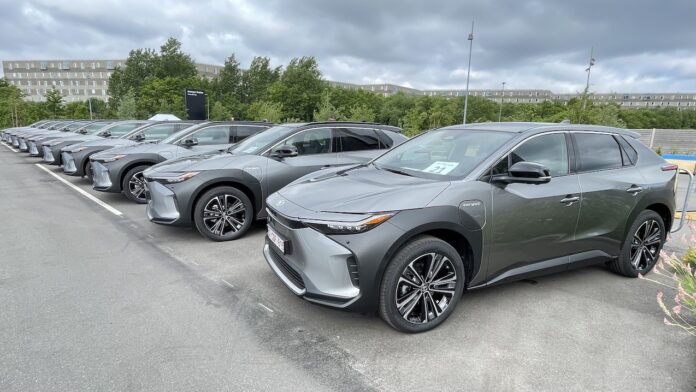10/06/2022 We went to wonderful Copenhagen for an exclusive test of Toyota’s first mass produced electric car the bZ4X prior to its arrival in Ireland. Looking much like a RAV4, the five-seat ‘bZ4X’ – and no that’s not its factory code name but its real showroom name… as in “Do you have a bZ4X I can take for a test drive?” The EV will be available in FWD front wheel drive single motor or dual motor AWD all wheel drive form. The name is a mouthful, and don’t worry I’ve told Toyota bosses on your behalf that it needs to be catchier. The ‘bZ’ bit stands for “beyond zero” Toyota’s green emissions-reducing strategy, while the ‘4X’ (reminds me of an Australia lager) implies off-road-ness but also a clue to its size. There will be other bZs in Toyota’s line up much like VW’s ID. range – so we can expect a 3 or 5 in the future.
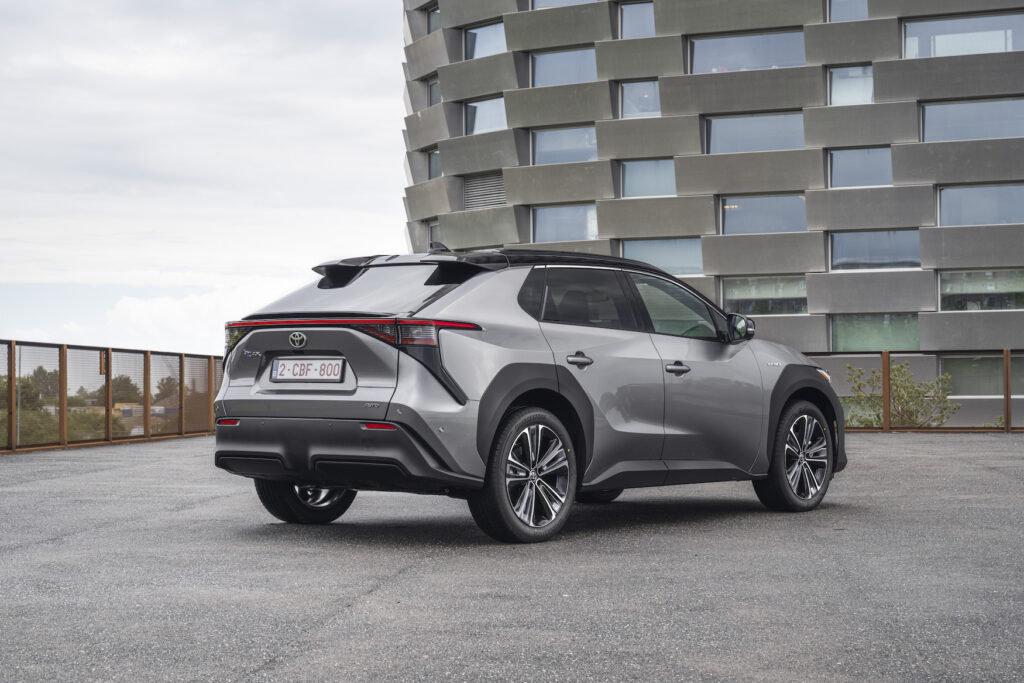
Built on Toyota’s e-TNGA platform, its body shape is that of a classic modern SUV soft-roader. Toyota says the car’s front end styling was inspired by a Hammerhead shark. The car at 4,690mm is slightly longer (+90mm) than a RAV4 and looks impressive in the flesh thanks to short overhangs and a relatively low roofline. Chunky wheel arches and some other SUV styling cues add to its go anywhere-ish styling that buyers still love. The car has a long wheelbase (2,850mm) and this delivers impressive rear passenger room. The car is cutting edge for Toyota and connected. A host of safety features as standard too (Toyota Safety Sense) – there is even a solar panel roof on the options list in certain markets.

The cabin has a premium feel. There is an abundance of space while the electric drivetrain also means there are a few nice areas freed up for more imaginative use. The high-set centre console can stow a large handbag or heels (a chat with the interior’s designer hinted the real credit for this innovative use of space should go to his wife). The centre console sits high and helps the driver and passenger feel as if they have their own cockpit area. The dash also does without a conventional glovebox and looks very sharp as a result with clean lines. Of course large digital displays feature. The driver gets a high set binnacle to display the main driving dials and its position helps keep their eyes on the road. There is also a sensor on the steering column that monitors if the driver’s eyes stray from forward for too long. If you’re inattentive an audible alarm will go off and the car can even cone to a halt if this happens when its adaptive cruise control is on. The boot holds 452 litres (441 litres with subwoofer).
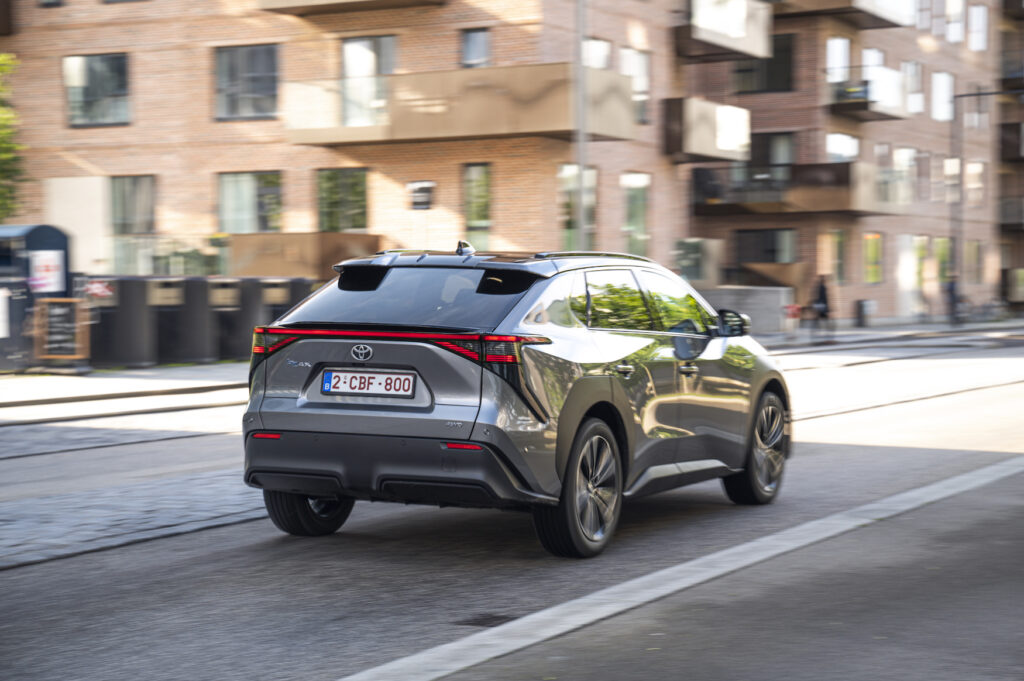
There is one large 71.4kWh battery as standard in the bZ4X. The maximum driving range from a full charge can be as high as 450km in the 204hp/266nm front-wheel drive version (in ideal conditions) or 417km in the 218hp/337nm AWD version we had on test. The bZ4X is a heavy car ranging from 1,895kgs – 2,065kgs, so don’t get overly giddy about the seemingly high power outputs. 18 inch alloys are standard with optional 20s, while the larger wheels look great they have a negative impact on range (and ride comfort to a degree). Average energy consumption is impressive at 15.4l/100km, and thankfully for Irish conditions a heat pump is standard. The liquid cooled underfloor battery pack (that is also a structural part of the car) is extremely well constructed and thermally managed. Toyota has given the pack significant attention to detail and guarantees its effectiveness to a greater degree than its rivals. The lithium-ion battery can charge at speeds is up to 150kW at rapid chargers e.g an 80% charge is possible in less than 30 minutes. The onboard charger has a modest 6.6kW capacity that will rise to 11kW (3 phase) at the end of the year when it goes in to production. The 6.6 perfectly adequate for home charing but the 11kW will allow you draw more electricity from public ‘slow’ chargers (22kW) and this is important as these charges are far more common than fast and rapid chargers. Its worth noting that in the bZ4X when power runs low and its ‘guess-ometre’ says you have 0% range/battery left, you have in fact circa 8%.
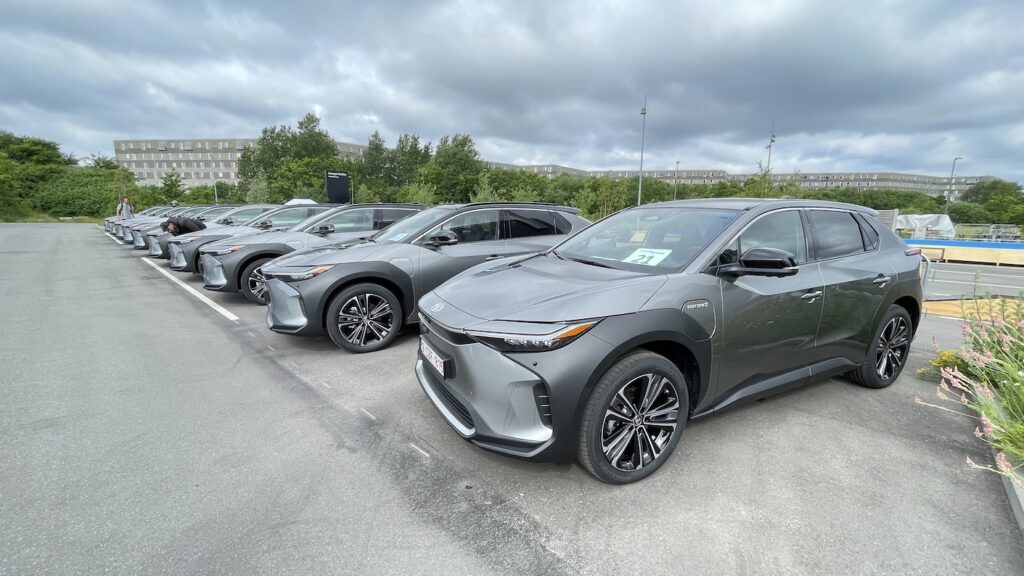
The bZ4x benefits from a low centre of gravity and couldn’t be easier to drive. You get in, press the power button, rotate the gear selector dial to ‘D’ and press the right pedal and away you go. The car is heavy but feels solid and in no way flabby. Toyota claims a class leading turning radius of 5.6 – 6.1 metres. The sprint from 0-100km/h takes a hot hatch-like 6.9 seconds (FWD 7.8 seconds). A one-pedal drive feature (like Nissan Leaf’s/Ariyah) can be activated too. In one-pedal mode we found its brake force a little weaker than ideal when you lift off the accelerator. We pointed this out to the Toyota big wigs, so it might be reviewed. On the roads around Denmark’s capital the bZ4X drove very well and coped with many of the city’s road imperfections. On twisty more rural roads the car felt swift, tight and controlled. Top speed is electronically restricted to 160km/h.
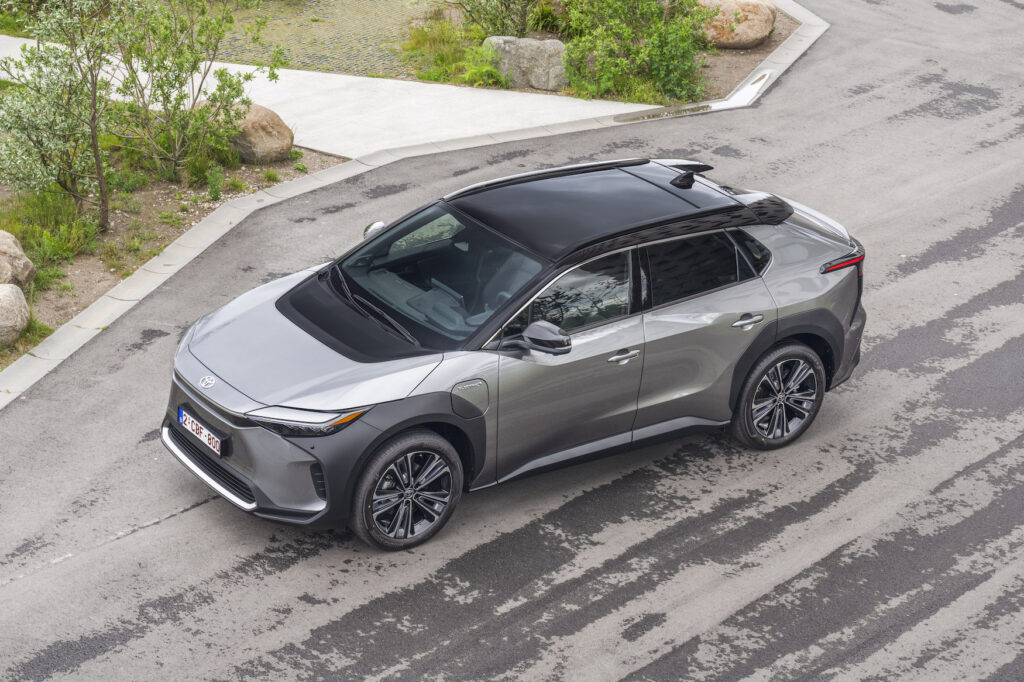
We tackled a dynamic handling circuit at Copenhill recycling plant where the car’s ability to wade through water was proven as the battery is waterproof and the car can wade through depths up to 500mm. A number of offset ramp axle articulation obstacles confirmed how impressively stiff the car’s body is. A steep tarmac hill ascent and descent allowed our top of the range AWD car’s electronics and X-Mode do their thing. X-Mode allowed us select a degree of forward creep that saw the car climb effortlessly up some steep angles – with our feet fully off the pedals! We’ve done more than a few off road courses where you expect to hear mechanical bangs and crunches but in the hushed Japan-built EV there were no audible distractions – just silence. We also went down the same climbs with hill decent control doing the hard work of maintaining traction and controlling speed. So we could not fault the electric Toyota for its all round ability on and off the road. Sadly we couldn’t take the car on to Copenhill’s rooftop ski slope but we’re sure it would have coped there too.

The front wheel drive version will be the big seller with Toyota bZ4X pricing starting from €45,275 net of incentives. Initially Ireland will get 666 units (arriving in mid summer) and this allocation will be made up of higher specification models mainly, and this year’s allocation is almost sold out. The worst thing about the Toyota bZ4X is its name and perhaps the fact that while it looks like an SUV it is certified to tow a modest 750kgs (braked). The rest is only good news. It is easy to use, versatile and will be a big seller for the Japanese brand. Michael Sheridan


